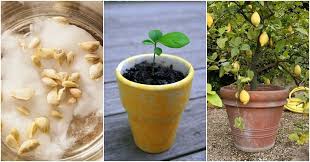Lemon trees are a delightful addition to any garden or patio. Their vibrant foliage, fragrant blossoms, and juicy fruits make them both beautiful and functional. Whether you’re a seasoned gardener or a beginner, growing a lemon tree successfully is an achievable and rewarding endeavor. This comprehensive guide will walk you through everything you need to know to plant and care for your lemon tree.
Why Grow a Lemon Tree?
Lemon trees are versatile and can be grown in the ground or containers, making them perfect for a variety of climates and spaces. They provide a constant supply of fresh, zesty lemons for cooking, beverages, and natural cleaning solutions. Moreover, their glossy leaves and fragrant flowers enhance any garden’s aesthetic appeal.
Choosing the Right Lemon Tree
The first step in growing a successful lemon tree is selecting the right variety:
- Meyer Lemon: Known for its sweeter, less acidic flavor. Ideal for smaller spaces and container gardening.
- Eureka Lemon: The classic lemon variety commonly found in supermarkets. Thrives in warm climates.
- Lisbon Lemon: Hardy and produces abundant fruit. A great choice for outdoor planting.
Steps to Planting and Growing a Lemon Tree
1. Selecting the Perfect Spot
Lemon trees thrive in full sunlight. Choose a location that gets at least 6-8 hours of direct sunlight daily. If planting indoors or on a patio, ensure the tree is placed near a sunny window or under grow lights.
2. Soil Preparation
Lemon trees prefer slightly acidic, well-draining soil with a pH of 5.5–6.5. Test your soil beforehand and amend it with compost or organic matter to enrich its nutrient content. If your soil is too alkaline, adding sulfur can help lower the pH.
3. Planting the Tree
- In the Ground:
- Dig a hole twice as wide and just as deep as the root ball.
- Gently loosen the roots and place the tree in the hole.
- Ensure the top of the root ball is level with the soil surface. Fill in the hole with soil, tamping it down gently.
- Water thoroughly to help the soil settle around the roots.
- In a Pot:
- Choose a container with good drainage holes.
- Use a citrus-specific potting mix or a well-draining general mix amended with sand and perlite.
- Plant the tree, leaving a few inches of space at the top for watering.
4. Watering
Lemon trees need consistent moisture but dislike soggy soil.
- Water deeply once or twice a week, allowing the top inch of soil to dry out between waterings.
- In pots, ensure excess water drains freely to prevent root rot.
5. Fertilizing
Feed your lemon tree with a balanced, citrus-specific fertilizer.
- Apply fertilizer every 4-6 weeks during the growing season (spring and summer).
- Reduce feeding in the fall and stop completely in winter when the tree enters dormancy.
6. Pruning and Maintenance
Pruning helps maintain the tree’s shape, remove deadwood, and improve air circulation.
- Remove suckers (shoots growing from the base) and crossing branches.
- Prune lightly in late winter or early spring before new growth starts.
7. Pollination
Most lemon trees are self-pollinating, meaning they don’t require a second tree for fruit production. However, if grown indoors, you may need to hand-pollinate flowers using a soft brush or cotton swab to transfer pollen between blooms.
8. Pest and Disease Management
Common issues include:
- Pests: Aphids, scale insects, and spider mites. Use neem oil or insecticidal soap to manage infestations.
- Diseases: Watch for citrus greening or root rot. Ensure proper drainage and avoid overwatering to keep your tree healthy.
When to Expect Fruit
Lemon trees typically begin bearing fruit 2-3 years after planting. The fruiting season varies by variety, but many trees produce lemons year-round with peak harvests in winter.
Harvesting Lemons
Lemons are ready to pick when:
- They are fully yellow (or greenish-yellow for certain varieties).
- They feel firm and have reached the expected size for the variety.
Use pruning shears or a knife to cut lemons from the tree, leaving a small part of the stem attached to prevent damage.
Caring for Your Lemon Tree in Winter
In colder climates, protect your lemon tree from frost:
- If grown in a container, move it indoors during freezing temperatures.
- For outdoor trees, use frost cloths or blankets to shield them from the cold.
Additional Tips for Success
- Mulching: Add a layer of mulch around the base of the tree to retain soil moisture and suppress weeds. Keep mulch a few inches away from the trunk to prevent rot.
- Companion Plants: Plant herbs like basil or lavender nearby to repel pests.
- Patience: Lemon trees take time to mature, but the payoff is worth the wait!
Conclusion
Growing a lemon tree is a delightful journey that rewards you with a year-round supply of fresh, zesty fruit. By choosing the right variety, providing adequate care, and maintaining proper conditions, you can enjoy a thriving lemon tree in your garden or home.
💬 Have you tried growing a lemon tree? Share your experiences below!
🌱 #LemonTreeLove #HomeGrownCitrus #GardeningTips #SustainableLiving

